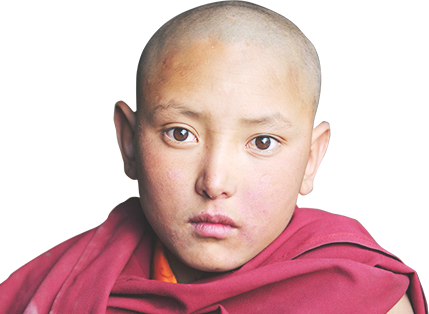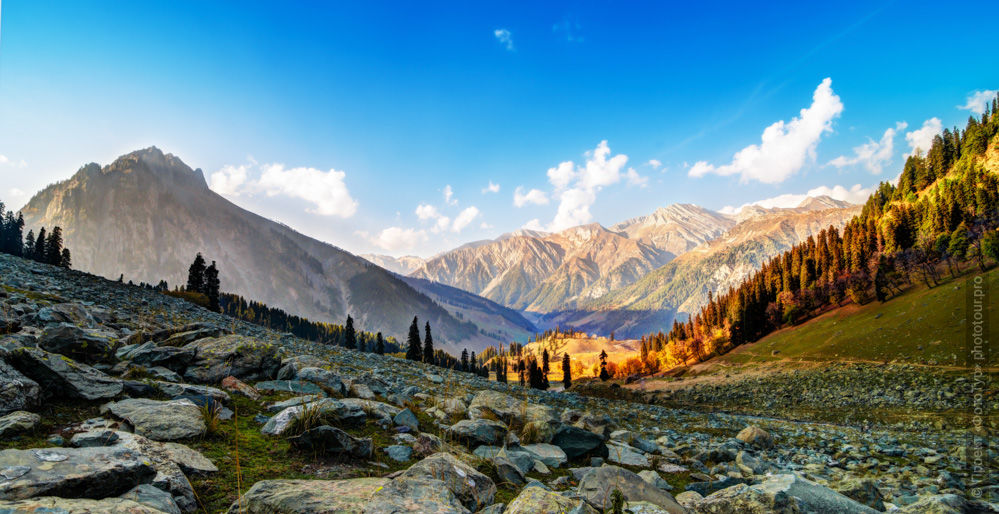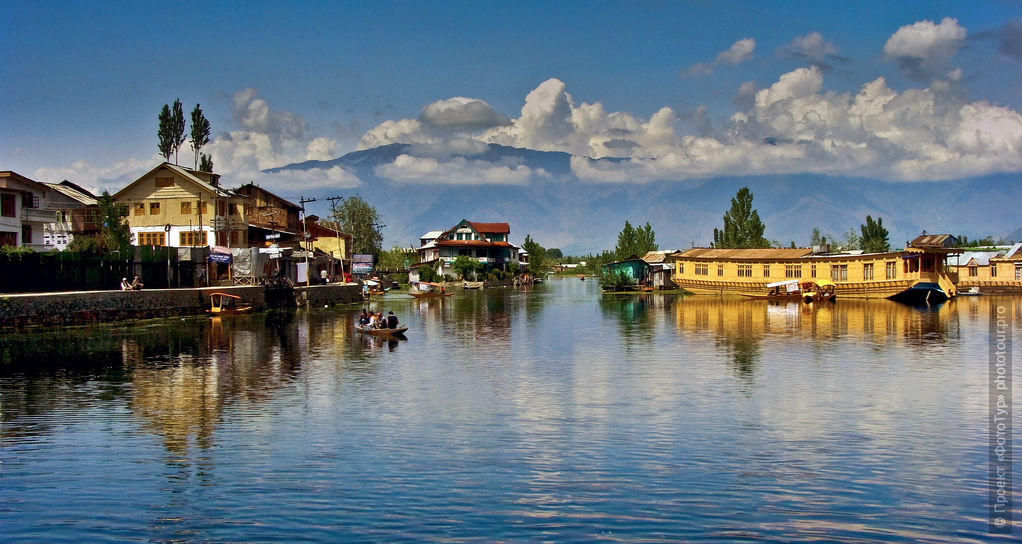The Booking of your participation in any journey takes place in three stages:
First step: Filling the application form for participation in the tour. Be sure to include your full name, We work officially and all accounts are registered. Please write your contact so that we have the communication wit you. After your application come to our website - the site administrator will send you a bill at your name for a advance of the tour. Maximum response time: 6 hours. Usually responsible for 1 hour.
Second stage: The reservation to participate in any tour takes place when you make the advance payment of 30% of the tour price to the account of an Indian travel company INCREDIBLE HIMALAYA. The advance is transferred via bank payment systems in any bank, account details will be sent by the administrator to e-mail of participants after getting the application form for participation.
ATTENTION Booking the tour takes place only when the advance payment transferred. If, after receiving of the invoice for advance payment, you do not make a payment within three working days, your application form for participation is automatically canceled by site. If you still want to participate in the tour, you have to apply the form again. When we receive an advance on our bank account we sent payment receipts confirming your participation, as well as a contract for the provision of travel services on this tour. The administrator sends you the electronic copies of receipts and contracts with digital signature and seal by e-mail and if necessary - to the postal address - the original documents. The remaining amount is payable as ayou arrive at the beginning of the trip, in India.
The third stage: Preparing for the journey. We also have a verbal communication on Skype with members of our travels. 2 weeks before the tour we gather the whole group in Skype and discuss preparations for the journey. Also welcome verbal individual consultations on Skype, it helps us to answer all your questions maximized. Because the most of the year we are in India, the main communication with us is Skype.
Attention! You don't need to register on our site to join the tour. If you are unable to fill the application form, please just send your application in letter (free form) - by mail: [email protected]
Attention! If you have not received a response to your letter within 6 hours (maximum response time for a request), please look at the spam folder. Perhaps, our letter got there by mistake. We always reply to requests in a maximally short period of time.
Photo expedition to Ladakh, Zanskar and Kashmir.
Day 1, August 29: Meeting at Leh airport, acclimatization, evening walk around Leh.
Day 2, August 30: In the morning visit to Thiksey Gonpa monastery, on the way back visit to White Stupas of Naropa.
Day 3, August 31: Transfer to Lamayuru valley, on the way visit to Basgo Gonpa and Alchi Gonpa monasteries.
Day 4, September 1: Aryan gorge Da Hanu, Skurbuchan Gonpa, rock monasteries, 11th century Avalokiteshvara gonpa, transfer to Lamayuru by the upper road.
Day 5, September 2: Morning puja of small lamas, Lamayuru Gonpa monastery. Visit to the Buddhist monastery of Wanla Gonpa.
Day 6, September 3: Transfer Lamayuru - Padum, three passes, full day on the road, Zangla.
Day 7, September 4: Half day off in Padum, evening walk to Stagrimo Gonpa.
Day 8, September 5: Road to Phugtal, 1.5-hour trek, visit to Phugtal Gonpa, return to Padum.
Day 9, September 6: Visit to Dzonkul Gonpa and Sani Gonpa monasteries, Guru Padmasamhaba lake.
Day 10, September 7: Visit to Stangdey Gonpa and Karsha Gonpa monasteries and Dorje Zong nunnery.
Day 11, September 8: Transfer to Kargil. Glaciers and Rangdum Gonpa Buddhist monastery on the way.
Day 12, September 9: Kargil – Srinagar.
Day 13, September 10: Srinagar, excursions.
Day 14, September 11: excursions to Srinagar + transfer to the airport.
Reservation of places for participation in the photo expedition "Ladakh, Zankar and Kashmir" is made upon payment of a deposit of 200 USD (or equivalent in Indian rupees) + 20% GST (goods and services tax) to the current account of the Indian tour company INCREDIBLE HIMALAYA PRIVATE LIMITED.
The deposit payment is transferred by the tour participant using payment banking systems in any bank, the bank account details are sent by the administrator to the participant's email after receiving the application for participation in the trip.
Upon payment of the deposit, the participant is sent a payment receipt confirming the deposit and the reservation of your participation in the trip, as well as an agreement for the provision of tour services for this tour.
The remaining amount is paid by the participant upon arrival at the starting point of the tour, in this case - upon arrival in Leh, Ladakh.
1. Transfers from/to the airport to the hotel in Leh.
2. Travel along the entire route (from the plane's steps to the steps) in comfortable cars.
3. Accommodation in warm and comfortable double rooms in hotels and guest houses along the tour route.
Accommodation in a single room is possible, an additional charge of 367 USD for the entire route.
4. Meals during stay in Padum - breakfasts and dinners.
5. Meals during stay on the houseboat in Srinagar - breakfasts and dinners included.
6. Information support by the organizers of the PhotoTour Project throughout the tour.
7. Excursion and full daytime support of an English-speaking guide of the PhotoTour Project.
8. Trekking support of a local English-speaking guide on the trail to Pukhtal Gonpa in Zanskar. 9. Payment of all taxes and fees along the tour route.
1. Flight to Delhi airport and back.
2. Flight Delhi - Leh and Srinagar - Delhi. Estimated cost of air tickets from $ 40 to $ 120.
3. Visa for 30 days for $ 25, issued online 10 days before arrival in India.
4. Entrance tickets to monasteries and monastery buildings cost about $ 10 for the entire time (if any).
5. Meals during the trip, about $ 160.
6. Cost of permits to closed border zones of Ladakh, Zanskar and Kashmir, about $ 20 per permit, 2 permits per tour route.
7. Payment for a boat when traveling for a photo shoot at the floating market in Srinagar: paid individually depending on the time and can cost from $ 5 to $ 20 per person in the boat.
8. Medical insurance: each tourist issues it individually at their place of residence.
9. Mandatory tips for drivers and English-speaking tour guide at the rate of $1 per day per tourist.
10. Anything that is not indicated as “Included in the tour price”.
The trip to Ladakh, Zanskar and Kashmir is designed for photographers and tourists from any country in the world.
ATTENTION!
This trip does not have any special requirements for physical condition and health:
health not lower than average.
There will be loads, but the loads are very average, without feats, the purpose of the trip is to see as much as possible, and for this purpose, very comfortable conditions are created on the tour at reasonable prices.
You should also not worry about altitude acclimatization:
we know how to carry out acclimatization and almost all of our tourists easily tolerate the climate and altitudes of Ladakh and Zanskar.
REGISTRATION FOR PARTICIPATION IN THE PHOTO EXPEDITION IS POSSIBLE UNTIL AUGUST 15, 2026.
But registration can continue earlier - as soon as a group of 8 people is formed.
If you want to go on this tour to Western Tibet, please book your place in advance.
This is a very comfortable trip, and since it will be quite cool indoors at night in September, special attention is paid to individual hotels on the tour:
Since the photo expedition to Ladakh, Zanskar and Kashmir has a very busy program, and we understand very well how important a comfortable rest at altitude is, all the hotels on the tour program are as comfortable as possible, there will be no trash with housing!!!
We do not accommodate our guests in the houses of local residents, tent camps and homestays, because such accommodation gives great fatigue from the tour.
Accommodation in the houses of local residents and homestays is - yes, inexpensive, but for Europeans - this is trash and a complete lack of opportunity to recover in comfortable conditions!
That is why we take pictures in the houses of local residents, and live in conditions suitable for recovery and a good rest.
In tent camps in the highlands - it is simply cold even in summer.
Hotels along the photo expedition route:
- LUX hotel in Leh, hot water, internet, huge garden, Leh center.
- Guest house in the Lamayuru Gonpa monastery, shower and toilet in the corridor, internet, we live practically in the gonpa, we go to morning and evening pujas.
- PREMIUM hotel in Padum, hot water, internet, breakfasts and dinners included.
- LUX BOUTIQUE hotel in Kargil, hot water, internet, Kargil center.
- PREMIUM HOUSEBOAT hotel in Srinagar, hot water, breakfasts and dinners included.
This is what the rooms of our hotel in Padum look like:
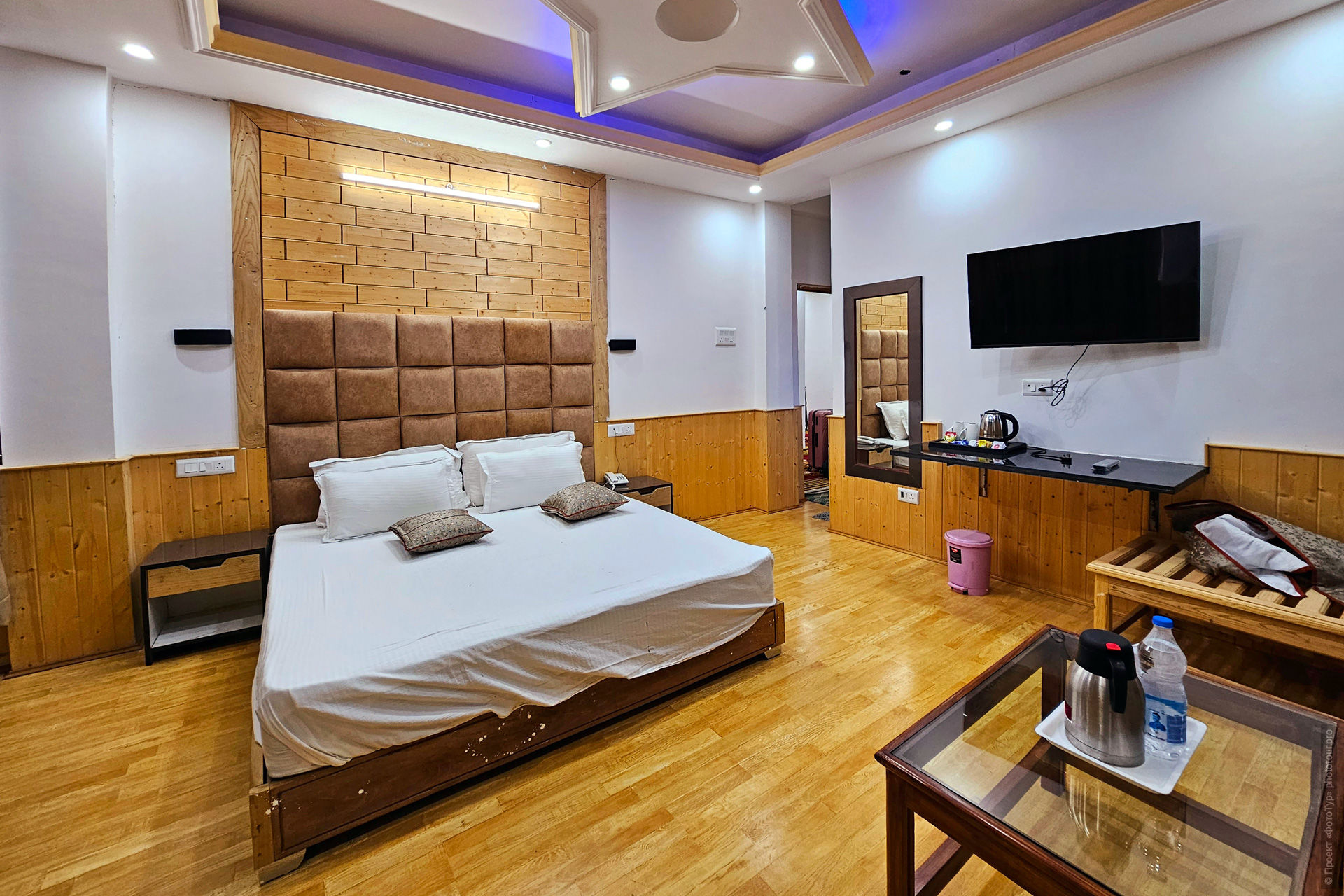
Transport:
Comfortable tempo-traveller and backup jeep.
All cars are new and comfortable.
For those who want to ask questions about the organization and participation in the photo expedition to Ladakh, Zanskar and Kashmir, please contact us:
Phone numbers for communication:
+ 91 94 1909 7049 - Telegram and WhatsApp - Ilona Kryzhanovskaya, co-director of INCREDIBLE HIMALAYA and head of the PhotoTour Project.
+ 7 903 720 47 71 (Russia) - Maxim Savchenko, technical director of the PhotoTour Project.
Facebook messenger:
Ilona Kryzhanovskaya - administrative questions about the tour, consultations on buying air tickets, you can write and call via messenger.
e-mail:
[email protected] - Ilona Kryzhanovskaya, head of the PhotoTour Project
[email protected] - Maxim Savchenko, director of the PhotoTour Project
The tour has a team of organizers:
Ilona Kryzhanovskaya - head of the PhotoTour Project, ethnographer, myth-building in photography, professional photographer.
Sonam Rinchen - partner and co-founder of the PhotoTour Project.
Lobzang - English-speaking Zanskari guide of the PhotoTour Project.
Maxim Savchenko - technical director of the PhotoTour Project.
Our local Ladakhi English-speaking guides-bearers of culture, the PhotoTour Project team.
A team of drivers-guides along the entire photo tour route.
It is difficult to describe this trip in a few sentences, probably like this:
this is an event-rich tour of three very remote and incredibly beautiful regions-cultures: Ladakh, Zanskar and Kashmir.
We can talk about each of these regions, each of these cultures forever.
Ladakh - the very name of this place is translated as "Land beyond the passes", the high valleys of Little Tibet - the only place on our planet where the real living culture of Tibetan Buddhism has been preserved to this day.
Zanskar is a mystical kingdom in the clouds, a real kingdom, because the most respected power in Zanskar is the royal family living in Zangla.
Zanskar is unique in all its manifestations: from the largest female Buddhist monasteries, polyandrous (polyandry) to ancient gonpa monasteries, the atmosphere in which breathes mysticism.
Kashmir - the history of this place goes back to the millennium BC, a place about which people have said since time immemorial: if there is a paradise on earth, then it exists right here, in Kashmir.
Three sacred cultures hidden in the mountains of the high Himalayas: in Ladakh, and in Zanskar, and in Kashmir, ordinary everyday life is inseparable and filled with-breathes with spirituality.
People come here not only, and not so much for the sky of unreal highland landscapes, but in order to visit-meet-feel the interaction with what is more often known as Places of Power.
In terms of photography: landscape photography, ethnographic portrait, genre, macro photography, animalistic and, of course, architectural - ancient monasteries on the slopes, rocks in Ladakh and Zanskar and the Mughal Gardens in Srinagar - for photographers, the tour will be oversaturated with photography, from such trips our guests bring personal exhibitions.
In terms of impressions:
a lot and very different, during these 14 days Time will stretch infinitely, filling each day of the tour to the limit - with new emotions, new sensations, new spaces, and will collect all this into a new life.
Returning to your country after such tours is equivalent to returning home from another planet.
We tried to describe each day of the trip in as much detail as possible, but it is difficult, almost impossible, to describe these places, they are too multifaceted and ambiguous at all levels, they are not just beautiful purely visually, all these three places-cultures fill-feed with their energies, return strength, give the opportunity to understand something in yourself, restore on a new level.
It is no coincidence that the most ancient spiritual teachings and practices were born here.
It is no coincidence that from time immemorial thinkers, philosophers, and finally saints, sought to get here through high passes, and nothing stopped them on the Path.
It is no coincidence that stories about Ladakh, Zanskar and Kashmir are passed down from mouth to mouth through the centuries as places where miracles happen, where you can change the line of Destiny, simply by reaching these lands, taking a breath of the local air, saturated with power.
And, yes, Roerich was here.
Most of the photos in the photo expedition description are clickable to a large size, just click on the photo and it will open in a new window.
The title describes the photo expeditions of each day in Ladakh, Zanskar and Kashmir, the approximate mileage for each day and the altitudes of the places visited are indicated.
Day 1, August 29: Meeting at the airport in Leh, acclimatization, evening walk in Leh, altitude 3,600 m.
Arrival at New Delhi International Airport from the country of residence.
Transfer from New Delhi International Airport to the domestic airport, and flight on the Delhi-Leh route.
We apply for an electronic visa, get our luggage and go to one of the domestic airline terminals:
D3 is in the same space,
D2 is a little further, you need to turn left from the international airline terminal building and walk 100 m through the tunnel.
This is a common practice on our tours to Ladakh:
flights on which participants of our tours arrive at New Delhi airport usually arrive at terminal D3 between 2 and 5 am, immediately go to the departure terminal and fly to Leh on one of the morning flights.
We take tickets for the Delhi - Leh flight so that the time reserve between the external and internal flights is 3-4 hours.
Flight to Leh, 1 hour 20 minutes.
The Delhi-Leh flight itself is an exciting photo-action for photographers, the plane flies over the most beautiful peaks of the Himalayas.
We highly recommend that when buying tickets, you book seats near the windows right away.
For those who want to photograph mountain ranges from the plane, the best seats will be from 25F to 30F and from 25A to 30A.
This one and a half hour flight Delhi-Leh is a breathtaking sight, the plane flies over the most beautiful peaks of the Himalayas, over the huge glaciers. We recommend booking seats on the left side of the plane in advance - when landing in Leh, this side is the most removable, and the best seats are from 27 to 30, so the plane's wing will not interfere.
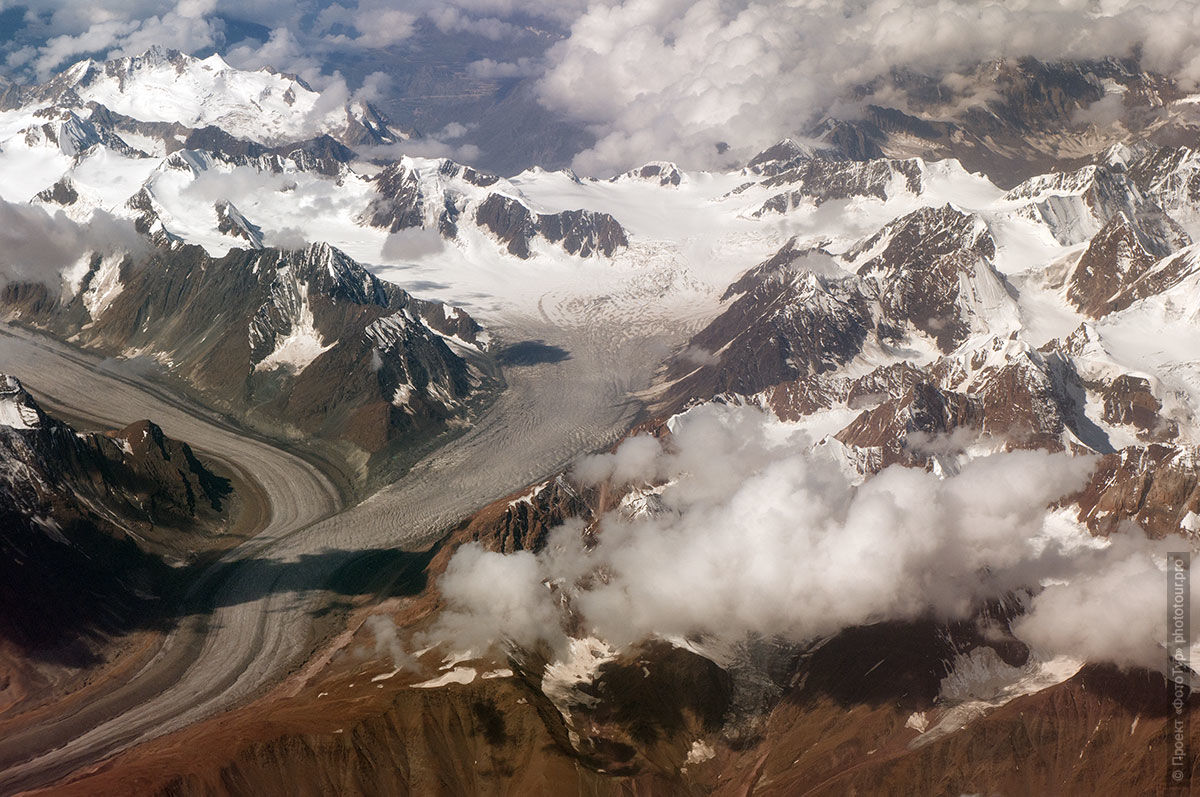
We arrive in Ladakh, the plane turns over the valley and lands at the only airport in the valley - in Leh. This dark ribbon is the initial runway for the whole of Ladakh and Zanskar.
The first day in Leh is for acclimatization: we drink tea, coffee and talk about the program of photo tour, in the afternoon - go on a leisurely walking through the center of Leh for the adaptation.
In the evening, after dinner, is a lecture about the introduction to the culture of Tibetan Buddhism in English.
The hotel in Leh.
Day 2, August 30: In the morning, visit the Thiksey Gonpa monastery, on the way back, visit the White Stupas of Naropa, about 30 km, altitude 3,600 m.
Early in the morning we go to the Buddhist monastery Thiksey Gonpa for the morning puja.
The link to Thiksey Gonpa is clickable - please read it, it describes in great detail Thiksey itself, and the morning puja, and everything we will see.
The Thiksey Gonpa monastery itself is huge, the largest in Ladakh, essentially a monastery city, with adjacent villages surrounded by ancient stupas, lama houses, monastic schools.
The Thiksey Gonpa monastery consists of twelve levels and ten temples rising on the mountain slopes.
At the very top are the private apartments of Rinpoche Gonpa.
Below the monastery itself, on the mountain slopes, the monks' hours and houses were shortened.
Now about 100 Gelug Buddhist monks live here.
From the roof of the monastery, incredible views open up and wonderful panoramas of the Ladakhi valley are photographed.
Lunch at the Thiksey Gonpa monastery.
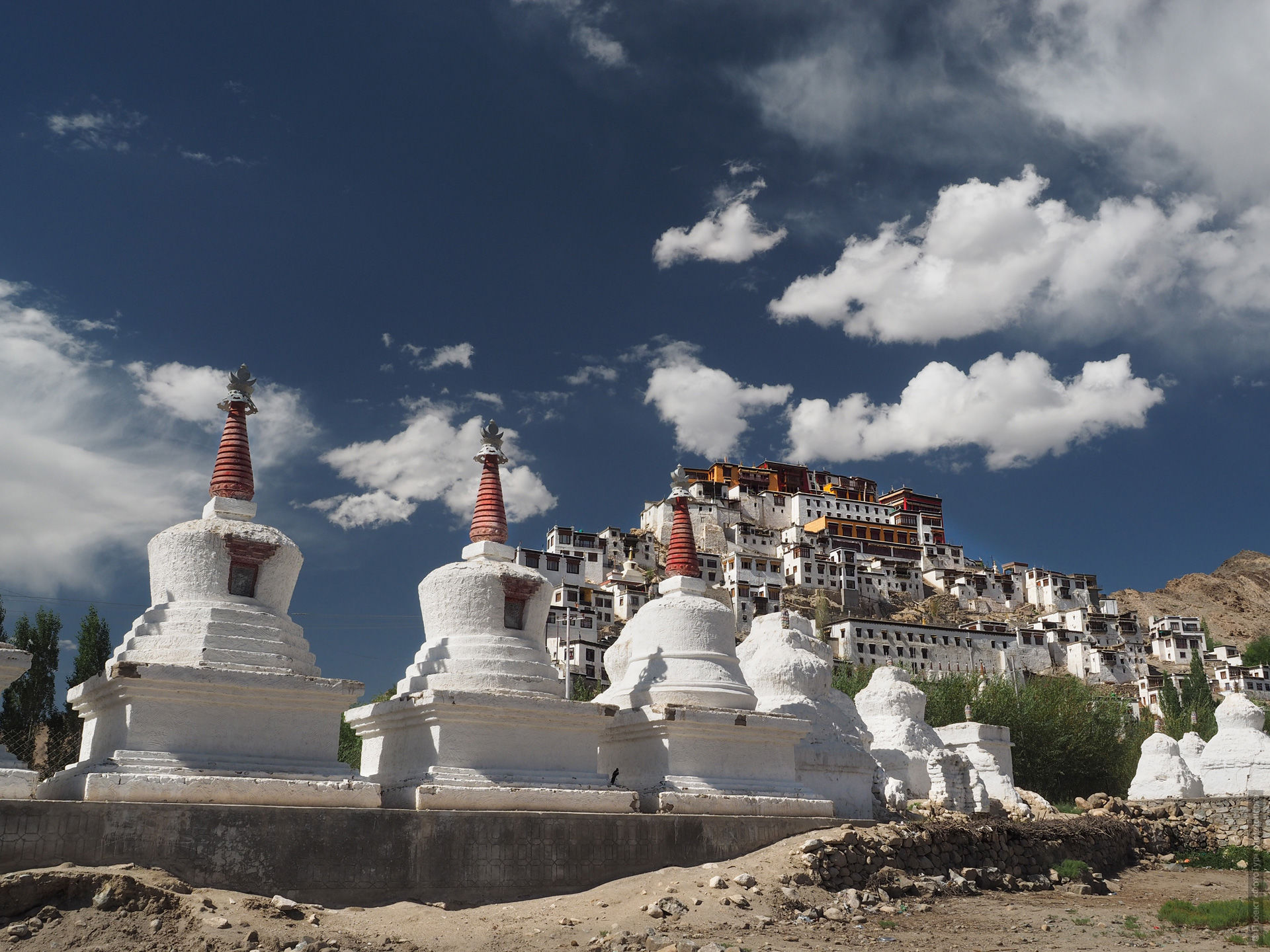
Our acclimatization day ends with a visit to the Buddhist monastery and palace of Shey Gonpa.
Shey Gompa is a complex consisting of the Gompa and the Palace of Shey on the Shey hill, in the past Shey was the second capital of Ladakh.
The monastery-gompa of Shey was also erected in 1655 by order of the king, in memory of his father, Sang Namgyal, as the heir to the palace.
The monastery has a copper, gold-plated statue of the seated Buddha Shakyamuni, this statue became famous throughout Ladakh and was the second largest at that time - 12 meters.
The monastery belongs to the Gelug tradition.

The hotel in Leh.
Day 3, August 31: Transfer to the Lamayuru Valley, on the way to visit the monasteries of Basgo Gonpa and Alchi Gonpa, about 140 km, altitude 3,000 m.
All day we slowly move down the Indus River with stops at the Buddhist monasteries of Basgo Gonpa and Alchi Gonpa.
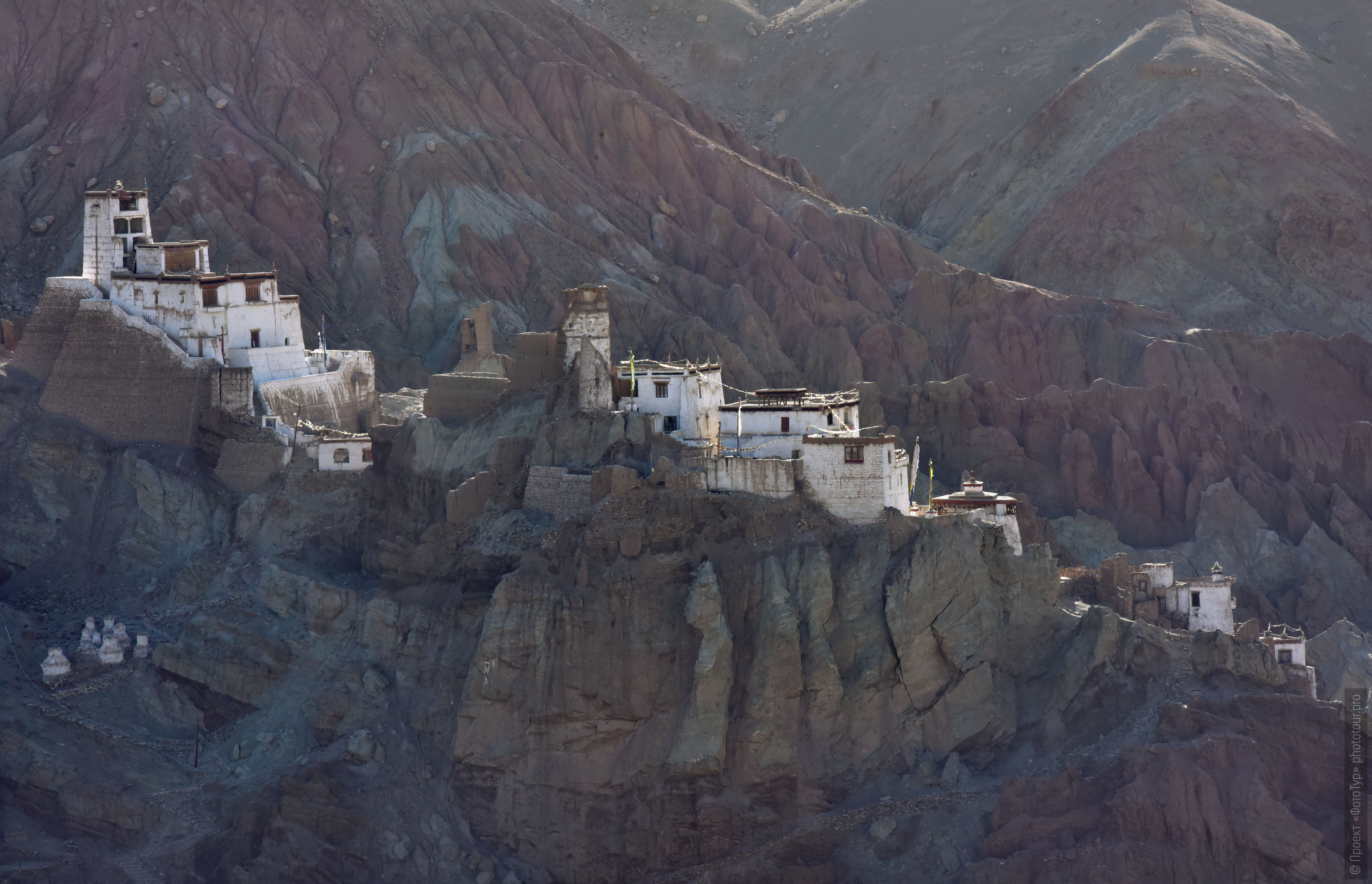
In the late afternoon we arrive in the Lamayuru Valley and settle into a cozy guest house at the Lamayuru Gonpa Buddhist Monastery.

Guest house at the Buddhist monastery Lamayuru Gonpa.
Day 4, September 1: Arian gorge Da Hannu, Skurbuchan Gonpa, rock monasteries, gonpa of Avalokiteshvara of the 11th century, about 50 km, altitude 3000 -3200 m.
After an early breakfast we set off to the colorful Arian gorge Da Hannu.
And we set off to drive along a very interesting old army road - with such incredible serpentines:
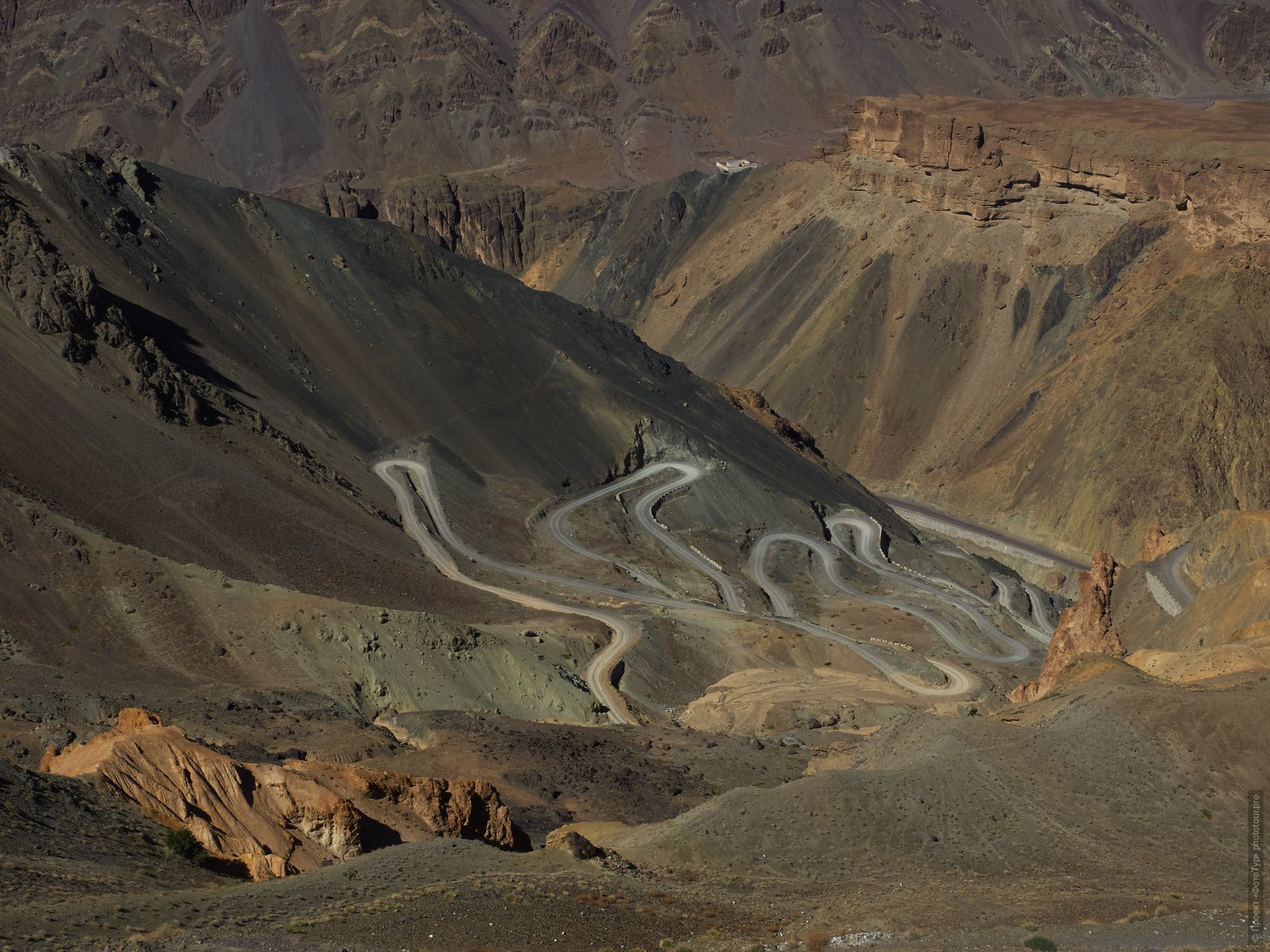
And further on, the incredible landscapes of Da Hannu await us - steep, sheer walls-pictures:

Rock monasteries and white Buddhist stupas among these walls:
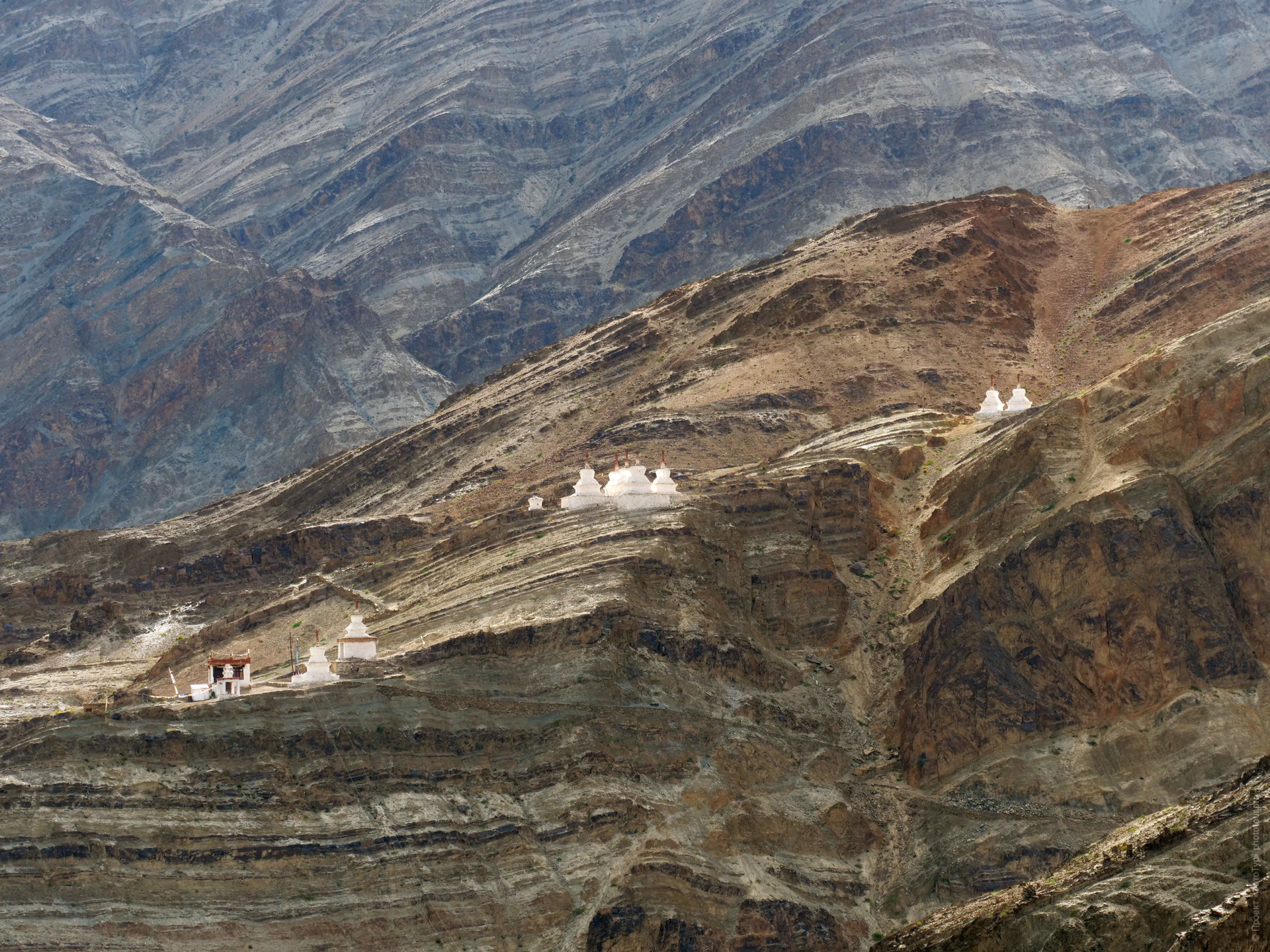
It is in one of these monasteries that we spend the whole day - in the village of Skurbuchan and in the gonpa of the same name Skurbuchan:
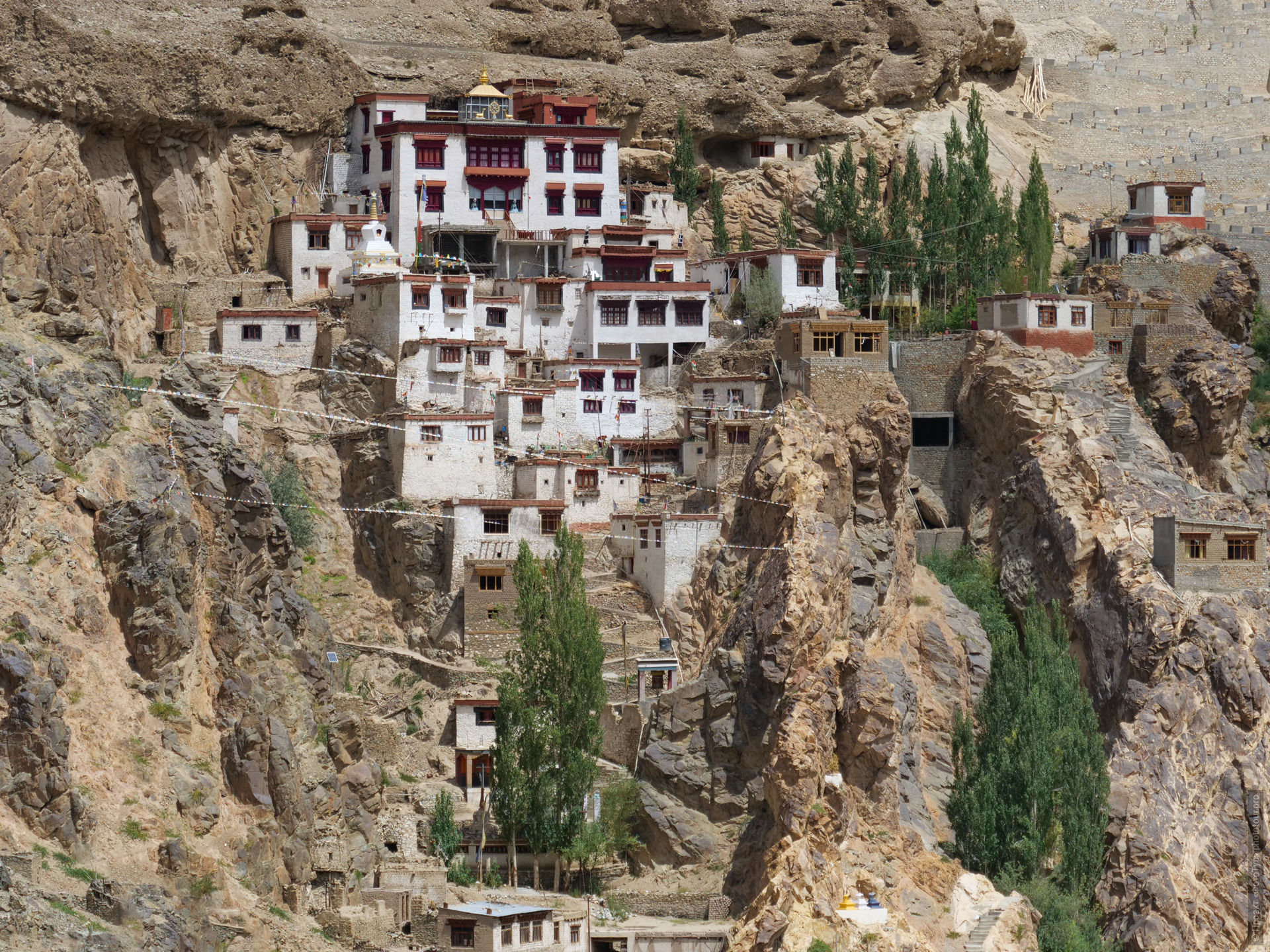
Guest house at the Buddhist monastery Lamayuru Gonpa.
Day 5, September 2: Morning puja of the little lamas, Lamayuru Gonpa Monastery. Visit to the Buddhist monastery of Wanly Gonpa. Moon Land. About 50 km, altitude 3,200 m.
At 5 am, anyone can attend the morning puja in one of the gonpas of the Buddhist monastery of Lamayuru, including the puja of the little lamas:
And then, after breakfast, we go to the ancient Aryan village of Wanlu and the monastery of the same name, Wanla Gonpa, standing on the top of a cliff:
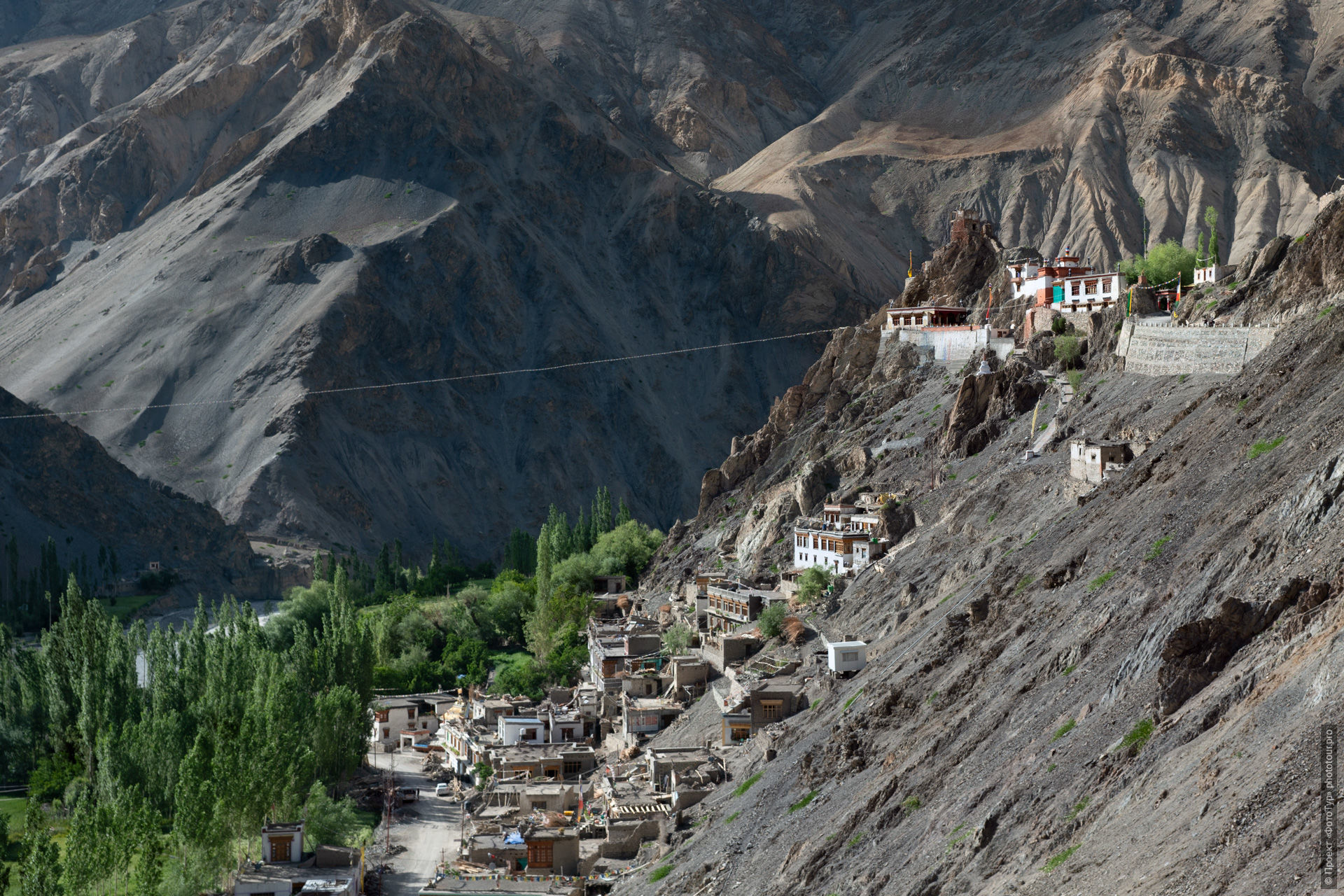
We will spend the afternoon at the Lamayuru Gonpa Buddhist Monastery.
The Lamayuru Buddhist Monastery (11th century) is one of the oldest monasteries in Ladakh, which existed in pre-Buddhist times and belongs to the Bon religion.
A Buddhist monastery of the Nyingma-pa (Red Caps) school was founded in its place in the 11th century.
It is believed that the famous Tibetan guru and yogi Naropa, who meditated for several years in a cave near the monastery, was behind the creation of the monastery.
The monastery houses a magnificent collection of thangkas and frescoes, a large number of shrines and relics.
The gompa stands against the backdrop of the unreal, fabulously beautiful mountain landscape of Moon Land.

And in the evening we will go once again to take photos of the Lunar Earth:
Guest house at the Buddhist monastery Lamayuru Gonpa.
Day 6, September 3: Transfer Lamayuru - Padum, three passes, full day on the road, on the way to Padum inspection of Zangla Gonpa and the old royal palace, about 200 km.
Altitudes 3,200 m - 5,000 m (passes) - 3,700 m (Padum).
Today is perhaps the most difficult day of our trip - along the new road to Padum we will cover a distance of about 200 km, visit two passes and along the new road enter from Zangla to Zanskar.
What awaits us today:
- very early rise,
- continuous, incredibly beautiful and very unusual road:
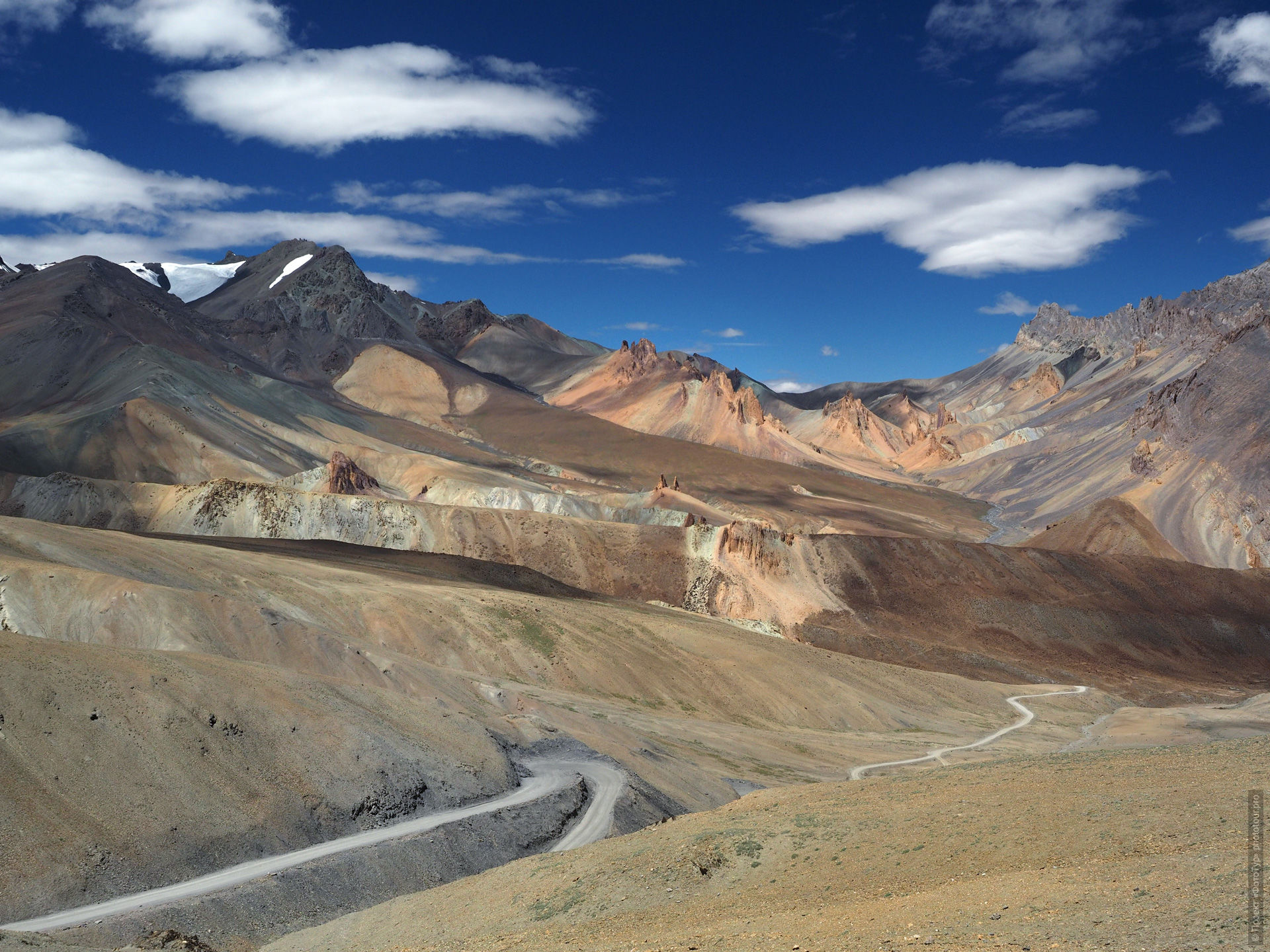
The road will surprise you - that's what we promise you: the landscapes will change one after another literally radically - steep gorges will change into gentle serpentines leading to 5000-meter passes:
Passes, we have 2 passes a day, where we will literally fly in the wind with Buddhist prayer flags Lung Ta:
Parakachik La Pass is the gateway to Zanskar. Population of Zanskar, with very few exceptions – are Buddhists.
Sunni Muslims compose a very small part of its total.
Most of nationalities living in Zanskar has a Tibetan and Indo-European origin. It Darda and Mona.
Considering the isolation of this area, its people have always had a tendency to self-sufficiency, while foreign trade was required to purchase goods that locals could not produce by their own.
The main business of people - it is the incubation of animals and cultivation of land, which is never enough.
Therefore, in Zanskar a complex system of irrigation is developed, in order to bringt o the fields enough water.
Due to the deficiency of land suitable for tillage, fertility and population are small in Zanskar.
The historical system of marriage and the family when several brothers are married to the same woman (polyandry), it was due to the need to maintain the population.
Buddhist monasteries in Zanskar are important monastic centers. Some of them are back millennia from the foundation.
Here, deep in the Himalayas, they protect and preserve the purity of the ancient teachings of the Buddha.
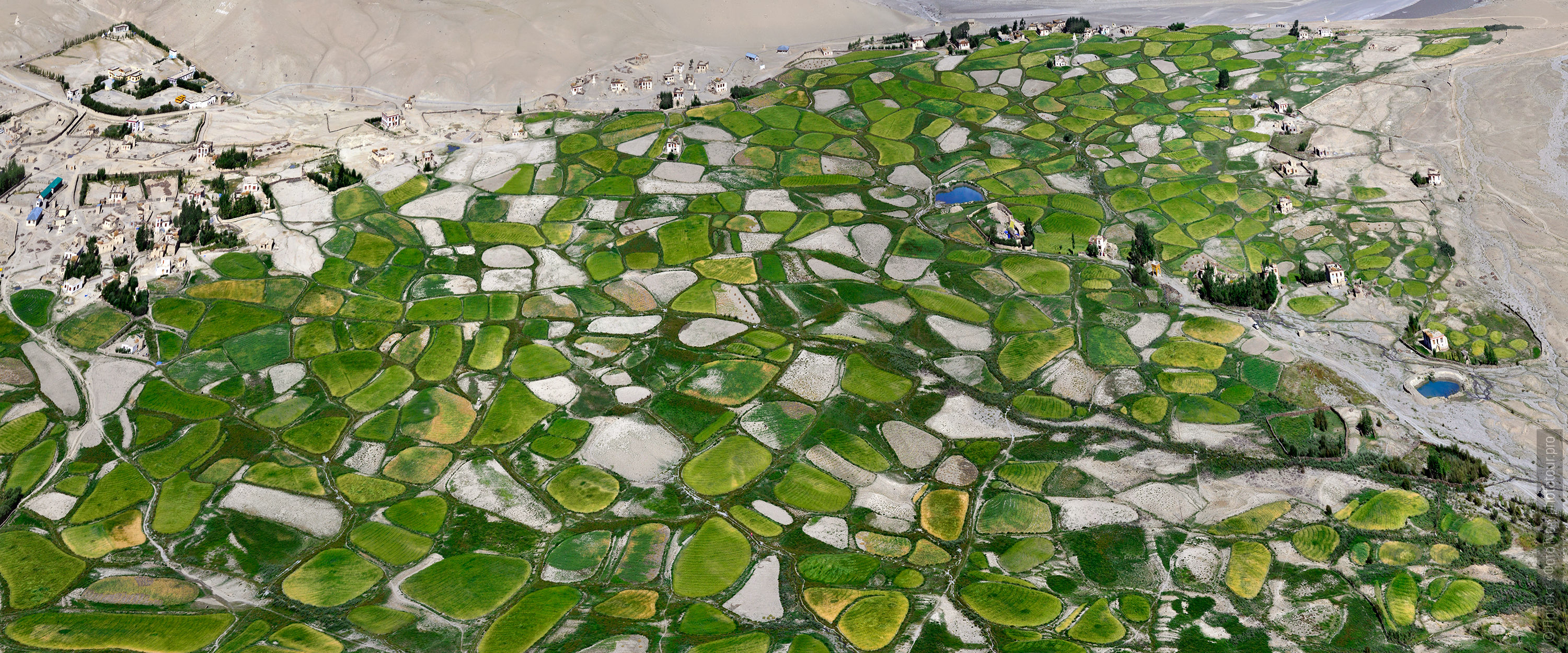
In the evening, entering Zanskar from the Zangla side, we will climb to Zangla Gonpa at sunset:

Late in the evening we arrive in Padum, settle into our cozy hotel, have dinner and - rest!
Hotel in Padum.
Day 7, September 4: Half-day off in Padum, evening walk to Stagrimo Gonpa.
Today is the only half-day off for the entire duration of our tour - we sleep and rest after yesterday's long journey.
Free time to get up, leisurely breakfast.
In the afternoon - we walk around Padum, get to know the village, and in the evening we take a traveler to the very height above the Padum valley - to the Buddhist monastery Rangdum Gonpa.
It is very atmospheric here, the old gonpa of the 15th century has been preserved, a new one has been built, here we will talk for the first time about the features of Tibetan Buddhism in Zanskar, and the lamas of the monastery will be our guides in this conversation.
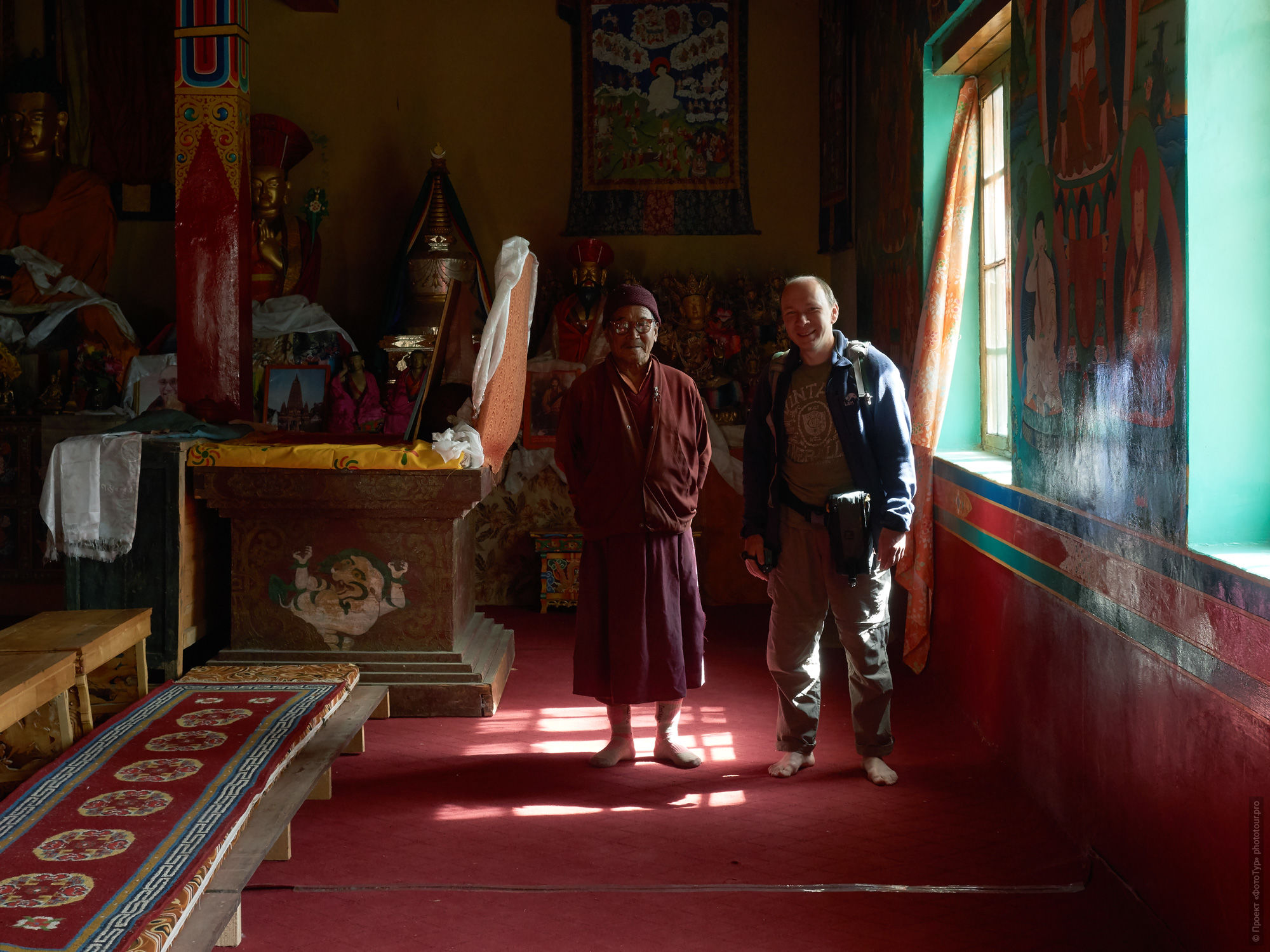
From the roof of Stagrimo Gonpa there is a panoramic view of the Paduma Valley and almost all the Buddhist monasteries of the valley, which we will visit in the coming days, are visible.
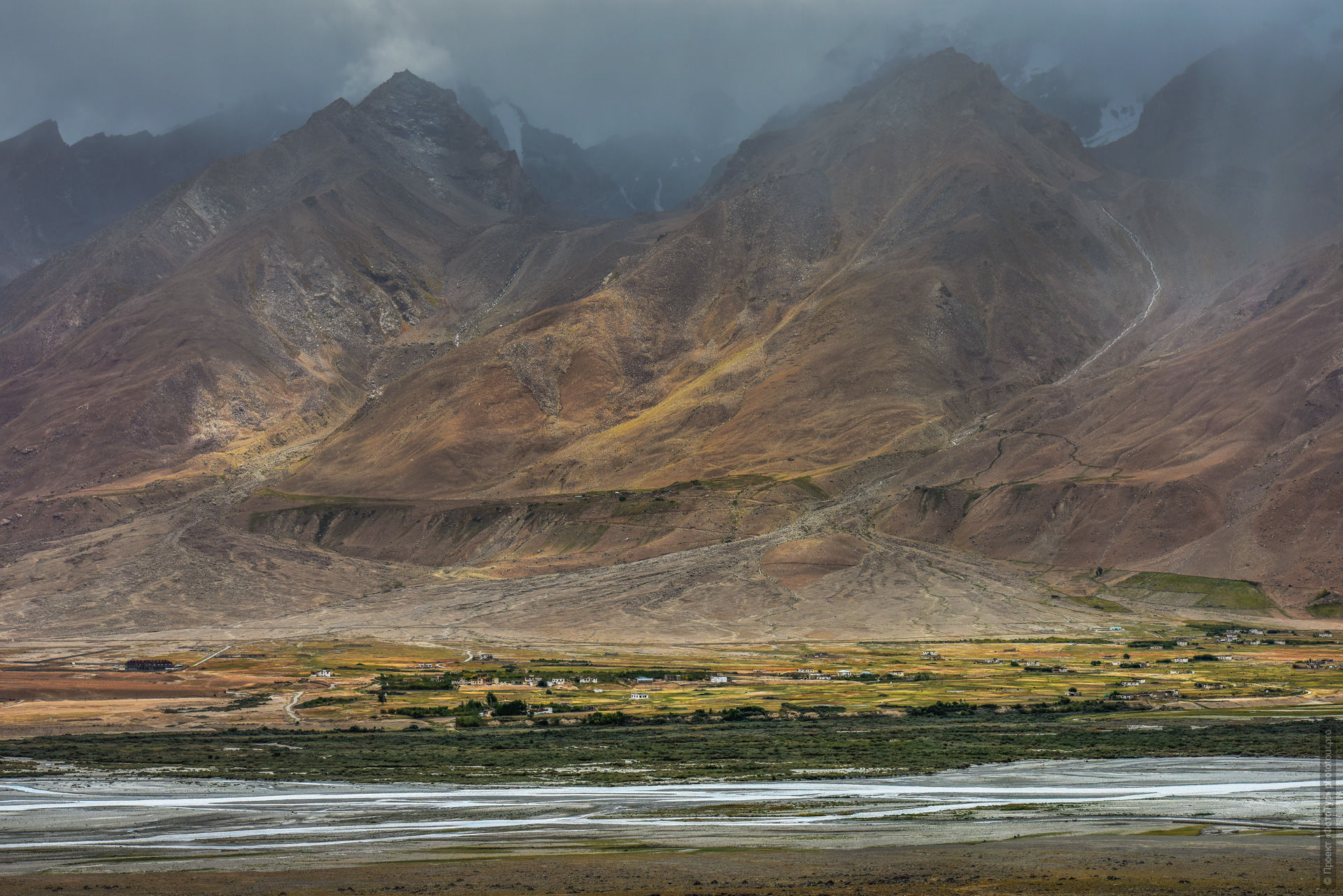
Hotel in Padum.
Day 8, September 5: Road to Phugtal, 1.5-hour trekking, visit to Phuktal (Phuktal) Gonpa, return to Padum, altitude from 3,600 to 4,200 m, about 200 km.
Very early rise, breakfast, at 06.00 departure towards the Buddhist monastery Phuktal Gonpa.
Trekking to the Buddhist monastery Phuktal Gonpa, trekking is not difficult, about 4 km one way.
Around 12.00 we are in the rock monastery Phuktal:
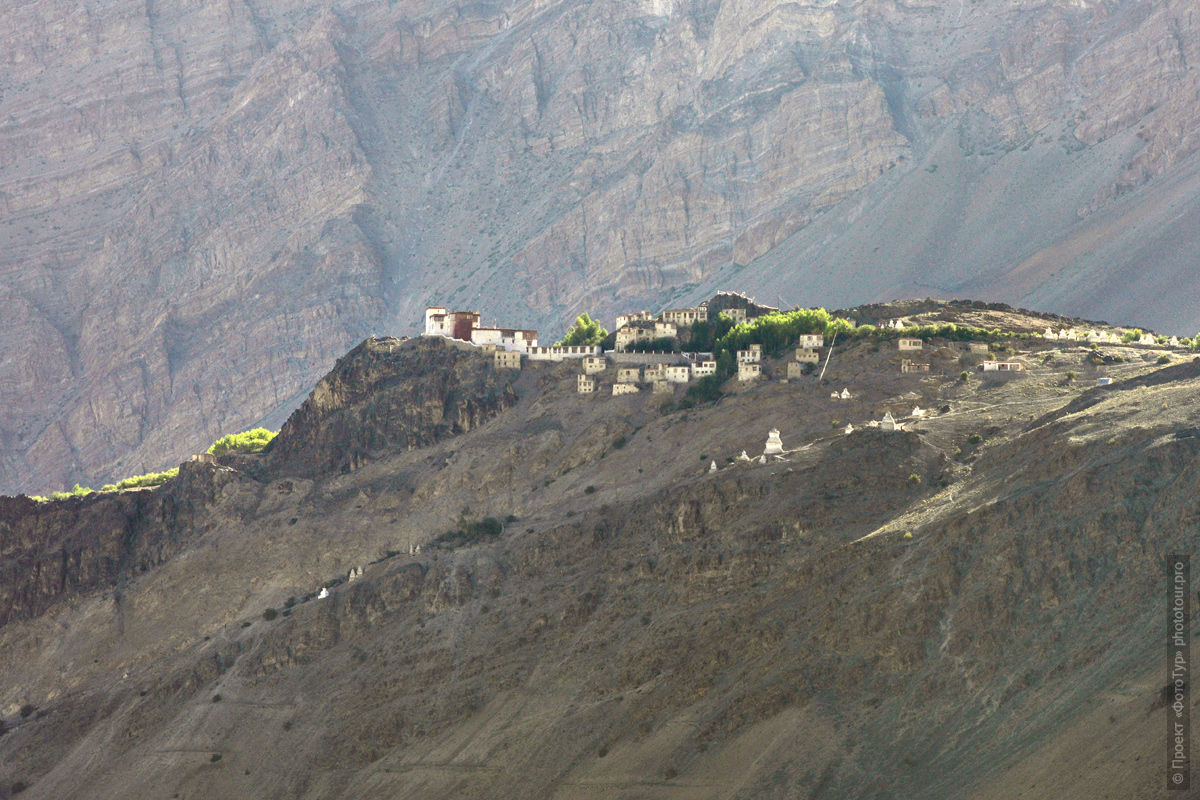
It was founded in 1052 by Lama Lhotak Marpa Cheski Lodos and belongs to the school of Tsongkhapa, this is the only monastery in Ladakh and Zanskar of Tsongkhapa school.
The monastery reached the greatest prosperity with the assistance of Shakya Zangpo.
It is believed that the supreme Lamas of the monastery are the reincarnation of Nari Tulku.
There are seven churches with a magnificent wall paintings decorating the interior.
The situation in the monastery is mystical, so the air seems to be saturated with a tantric energies.

In the afternoon we go to the Zangla valley and visit Zangla Gonpa, the royal palace, and with a favorable karma would get an audience with the King of Zangla, who is essentially is a King of Zanskar.
Buddhist monastery Zangla is the ancient monastery over the precipice, there are the ruins of the convent and the old castle near it. In the afternoon the ethnographic photography is planned in the Zangla village.
And late in the afternoon - we will take pictures of landscapes in the Zangla Valley under the evening sun.
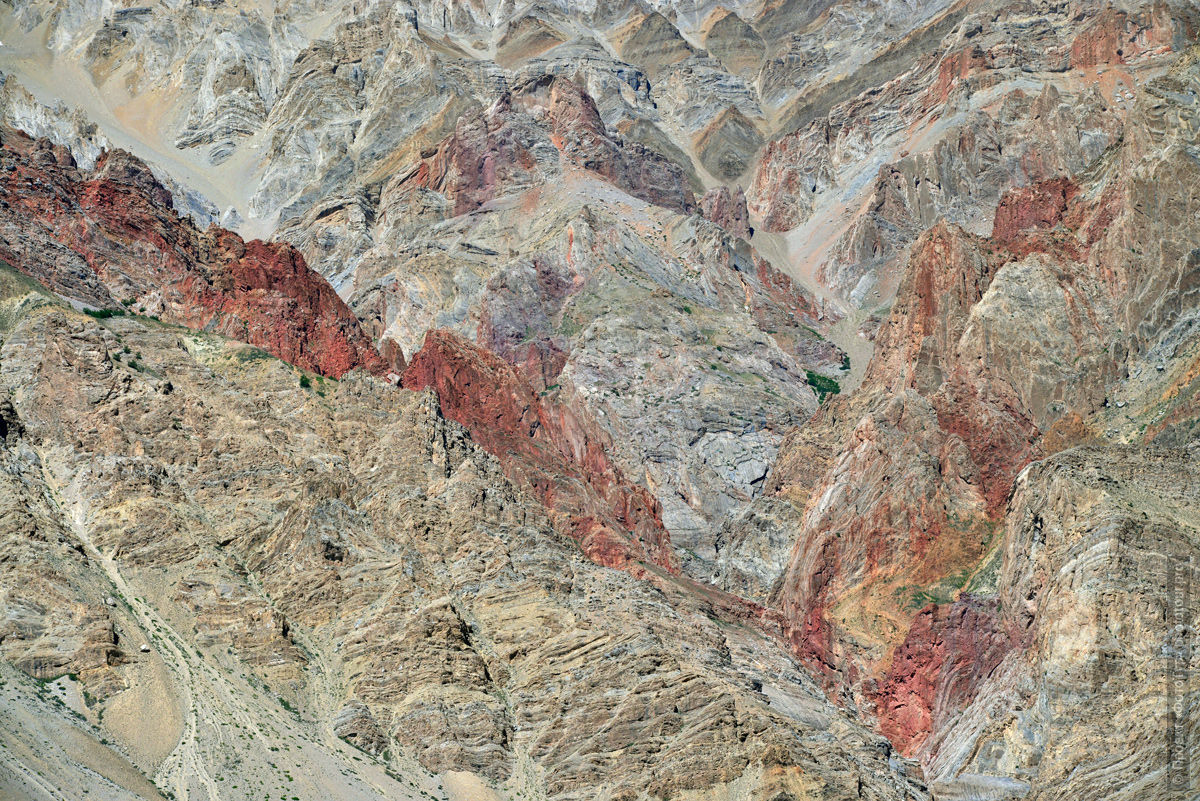
Zangla is simply amazing by variety of forms of weathering on the banks of the numerous streams, and by the mountains – the mountains in Zangla have a variety of colors, rocks are crushed in the form of incredible folds.
Guest-house – hotel in Padum.
Day 9, September 6: Padum - Rangdum - Kargil.
We go way back by the known road.
Many stops at the known places that will see a completely new way in a different light.

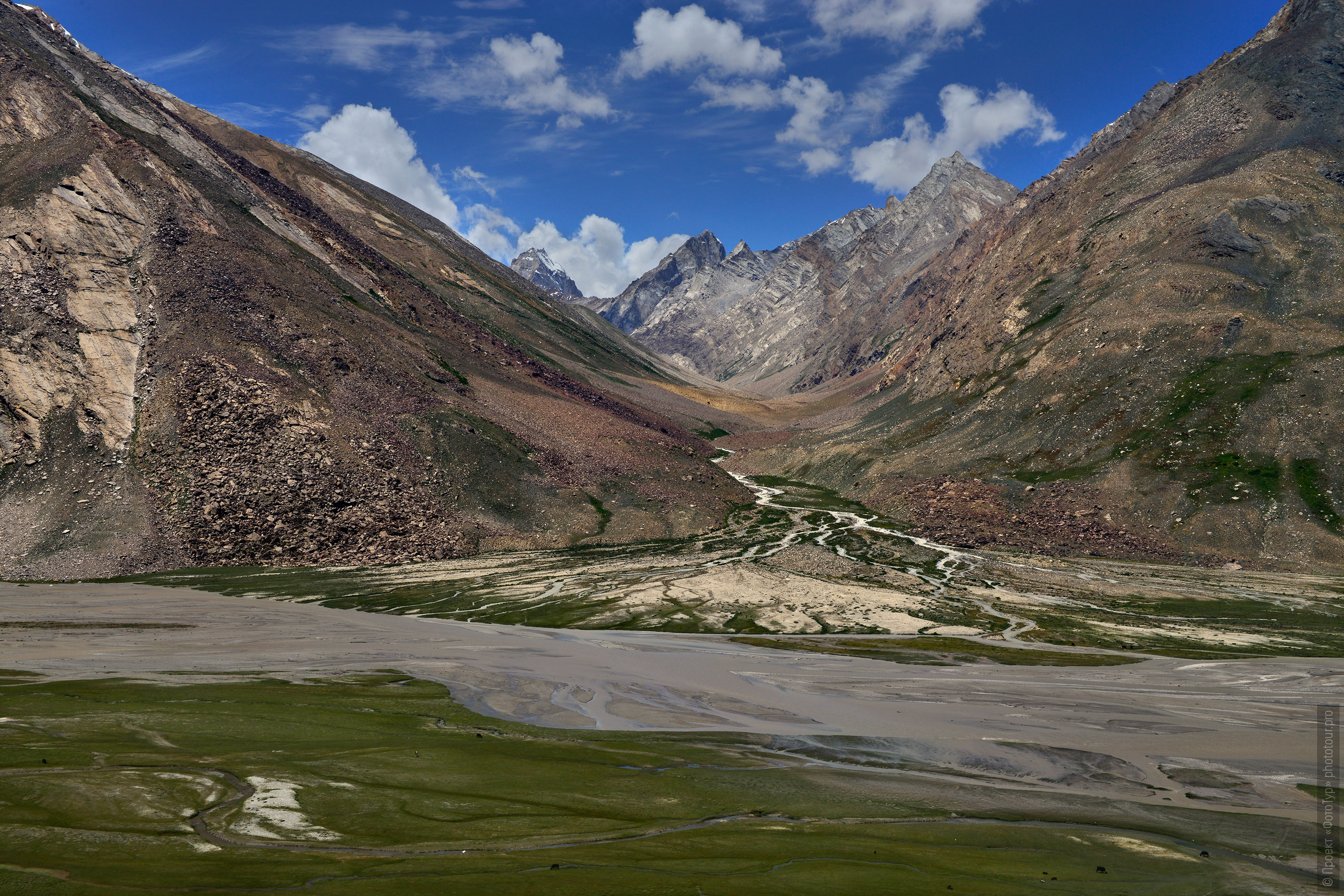
The road between Kargil and Padum was built only in 1980, and before that time Zanskar had only pedestrian connection with the outside world, or riding on the undersized Tibetan horses.
At midday, we will stop for lunch in the alpine Rangdum village and visit Rangdum Gonpa.
Monastery Rangdum Gompa (XVIII century) - is a monastery on a hill and serves as an outpost on the way to the valley.
This is a typical example of a monastery-fortress, where all surrounding areas are clearly visible.
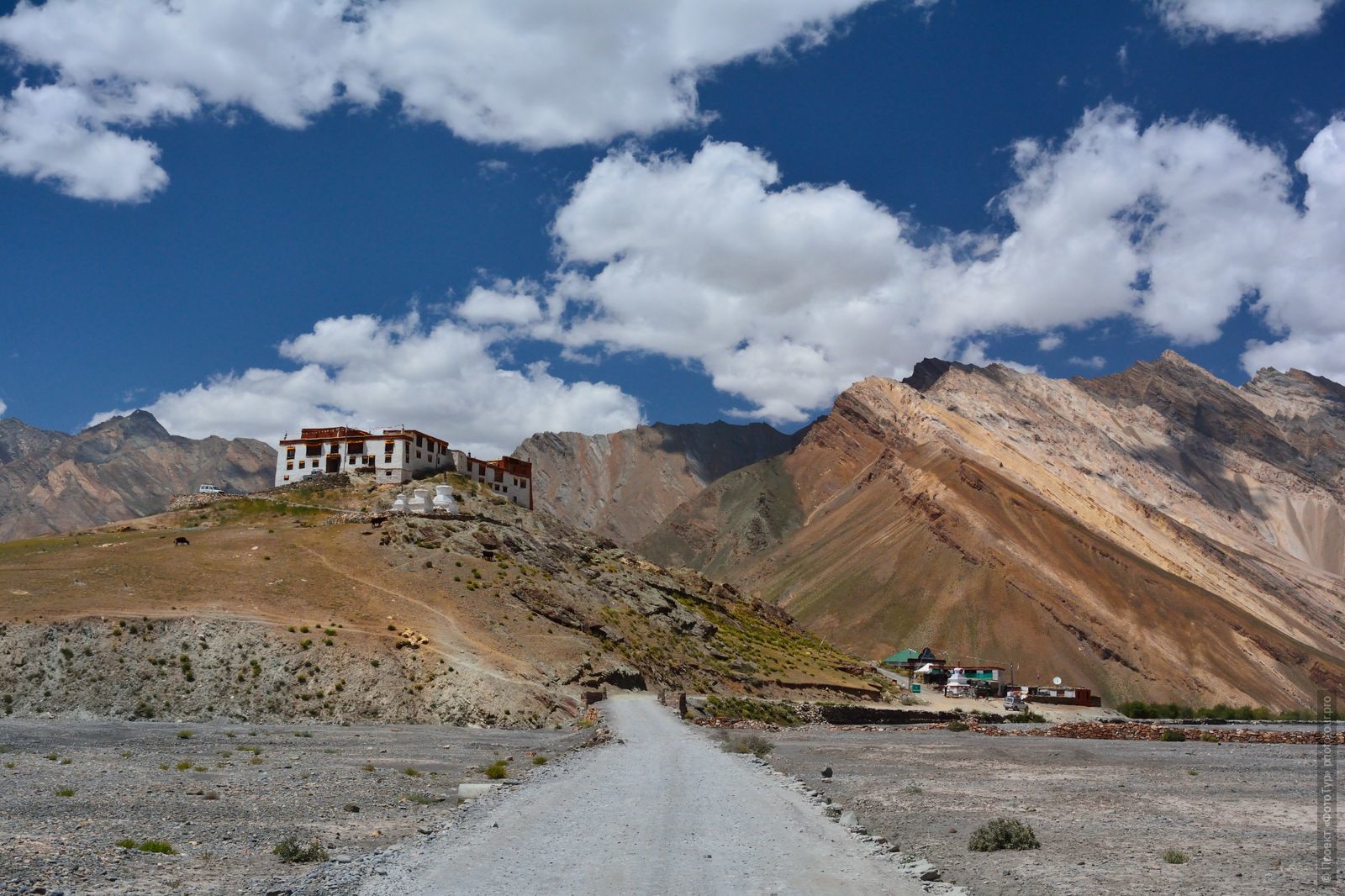
The monastery has a small museum with interesting Buddhist relics, stand with the photographs of lamas of the monastery, made in the last century.
We take a walk through the underground passages of Gonpa, roll the ancient prayer drums and go to our further way to Padum.

In the evening we arrive at Kargil, in a well-known guest house, have dinner and rest.
Guest house in Kargil.
Day 10, September 7: Kargil - Drass - Sonamarg - Srinagar. Kashmir. House-boat. 200 km.
Early wake up and we go by beautiful mountain road from Kargil to Srinagar.
The area changes considerably with each tens of kilometers: becoming more and more green, there are more and more numerous multicolored polygonal fields, large herds of long-haired sheeps - all these excellent reasons for numerous landscape stops on the road from Kargil to Srinagar.
The air becomes thick and heavy, you can literally drink the scent of alpine herbs, soak up with every sip-breath, we are gradually losing the height, descending lower and lower in the summer capital of Jammu and Kashmir - Srinagar.
We enter the Muslim India.
On the way we have stops at the Drass and Sonamarg.
Drass village: a charming mountain village situated in the valley with the same name, where winter temperatures drop to 65C degrees below zero, so the village is firmly holding the second place as the most cold inhabited round-a-year place on our planet.
From route the breathtaking views of Kargil and the famous Tiger Mountain offers .
Drass is located at an altitude of 3280 m in 56 km from Kargil in the federal highway Kargil - Srinagar, the village is often called the "Gateway of Ladakh".
There are a lot of Dards and Indo-Aryans who settled here in ancient times from Central Asia among villagers of Drass.
They talk on the Sheene, adardian dialect. Most of them are the Muslims and the rest are the Buddhists, the population in the village is about 1,500 people.
Drass Valley merges with Zodzhi Pass to Ladakh. Locals worked as a guides for the caravan crossing this difficult and dangerous pass.
Thus, they created a monopoly on the porters during the heyday of pan-Asian trade.
The harsh climate tempered Drass people and they rightfully could be considered as the guardians of the gates of Ladakh.

Sonamarg (Sonmarg) - a beautiful mountain valley completely covered with alpine meadows and the eponymous small village settlement on the road between Srinagar and Kargil, the height is 2750 m, 90 km to Srinagar.
At one time Sonamarg was a popular winter resort, but now it has more military than tourists because of its proximity to the disputed territory on the border with Pakistan.
You can meet a lot of pilgrims in the village of Sonamarg traveling from here, first to a small mountain village Baltal, where is the camp of the pilgrims, and then farther – to the one of the most famous Hindu shrines - the sacred cave of Amarnath (day of the journey), inside of which are never melting ice blocks, personifying the lingam of Lord Shiva.
According to legend, in this place the great Shiva explained the secret of the life to his wife Parvati.
We stop for lunch, take pictures. If you wish, you can take a short walk on horseback with local guides.
By the way, literally "Sonamarg" or "Son Marg" translates as "Golden Meadows" or "Golden Valley" and if we are lucky with the weather, we will be able to catch this amazing state-vision of Sonmarg.
And we continue our journey further - to Srinagar.
Srinagar is on the River Jhelum, at an altitude of 1730 m and 650 km north-north-west of New Delhi. Nine bridges connect the shores of the city with each other.
After days spent in quiet Ladakh the town seems huge and noisy, Srinagar population is nearly 1.5 million people.
Srinagar is an ancient city: it was founded, at least in the 3rd century BC. and was known under different names.
It is assumed that the city was founded by the king Pravarasena II about 2000 years ago under the name Parvasenpur.
During the reign of Ashoka in the Kashmir valley came Buddhism. Areas adjacent to the city and became the center of Buddhism.
In the 1st century, the region came under the control of the Kushan Empire, which controlled the territory of modern Pakistan and Afghanistan.
Some of the rulers of this dynasty supported the spread of Buddhist teaching.
Around the year 960 Srinagar became the capital of Kashmir.
Panorama with houseboats on the Lake Dal, Srinagar, Kashmir is clickable to a large size.
Buddhism came to the Kashmir valley during the reign of Ashoka. Areas adjacent to the city became the center of Buddhism.
According a legends, Srinagar is the place where is the tomb of Jesus Christ.
Mentions of the tomb of Jesus in Srinagar are from Sufi communities. In accordance with the Sufi tradition, the holy graves are more the places of veneration of saints and Sufi ritual places than the actual graves.
The tomb of Jesus Christ is called Rozabal and located in Srinagar near the mosque Dastgir Sahib.
This mausoleum of Jesus Christ has a form of a tall rectangular building, enclosed by an iron fence.
Purportedly there is the body of Jesus inside the tomb, and a stone imprint of his foot with signs of wounds received during the crucifixion.
Here Jesus of Nazareth buried, who had arrived in Kashmir, some time after the crucifixion and lived there for the rest of his life, got married, had several children and died at a ripe old age.
The population of Kashmir respected him as a prophet, and after his death the mausoleum was erected.
Kashmiri Muslims call it the tomb of the Holy Issa, son of Mariam, one of the 28 prophets of Islam (along with Muhammad and Moses), mentioned in the Quran in connection with the advent of Christianity as an intermediate form of the teachings of Judaism before the advent of Islam, Muslims believe that is the culmination of monotheism.
The name of Jesus is written on the tomb - Yuza Asaph where Yuza (Yuzha) - distorted Yeshua, Asaf is translated from the local language as the Shepherd ("Christ").
Jesus, not to mention Moses, whose tomb is located in Kashmir, 80 km from the tomb of Jesus, is not revered by Muslims as active as Mohammed, and this is one of the reasons for relatively deserted this place in the now 100% Muslim Srinagar, war-torn in result of forced Islamization of Kashmir last five centuries and also especially suffering from the last fifty years of constant conflict of Muslims with Hindus and Sikhs.
This place is sacred to Hindus, Buddhists and Muslims, but in 2010 the authorities closed the mausoleum of Kashmir to foreigners.
Srinagar amazes with its history and there you can be indefinitely, this time as if etched-frozen with majestic temples.
And yet – Srinagar is a very beautiful city: pouring Jhelum forms several lakes, the most famous is the Dal Lake, and Srinagar is especially famous for its canals, streets, reminiscent of Venice, and, of course, infinitely interesting place for photographers.
And at the end of our day we will stop to rest in the houseboat (the house on the water) on the Lake Dal.
What is the Houseboat: this is essentially a house on the water.
These houses do not float on the lake, and they are anchored near the shore or at some distance from the shore at special piers.
Houseboat is a wooden barge on the model of floating houses, which began to appear on the Dal Lake and in the surrounding waters in the 19th century, when the British began to actively come to Srinagar and Srinagar has become to transform beyond recognition under the influence of British culture: so the ruling Maharaja, frightened by too much pressure of English style on Indian architecture, banned the construction of houses on the ground foundation in Srinagar for foreign nationals.
But the British were allowed to build houses on the water.
The first such house with all the amenities launched the late nineteenth century. And then it began a massive construction of houseboats, known as "Little England corners on the Lake Dal."
Now houseboats of Srinagar are the national pride of Kashmiris.
Houseboat has several furnished in colonial style living rooms with a toilet, a shower with hot water, kitchen, hall, living room, service staff - in fact it is a small hotel.
It is usually attached with shikhara (dinghy) for trips on the lake.
As a rule, the houseboat is built from local pine trees and reach 24-38 meters long and 3-6 meters wide.
In this kind of hotel we will live three days in Srinagar.
Houseboat on the Lake Dal.
Day 11 September 8: Free day on the houseboat. In the evening we will have 3-hour walk on the Dal Lake.
Resting after a long and eventful mountain roads, clean feathers and techniques, view captured photos.
In the afternoon - water excursion on the shikhara around the Lake Dal.
What is the shikhara: a huge wooden boat with a canopy-booth.
A gorgeous special shikhara-men drives the shikhara, and quite brilliantly drives with just a single heart-shaped paddle.
It is said that this form of the paddle is a proof of the truthfulness legends and hypotheses about the life of Jesus and the Jews in Kashmir.
By the way, the heart-shaped paddles are also used in Palestine.
Shikhara-man is a very honorable profession in Srinagar, and, of course, is very profitable.
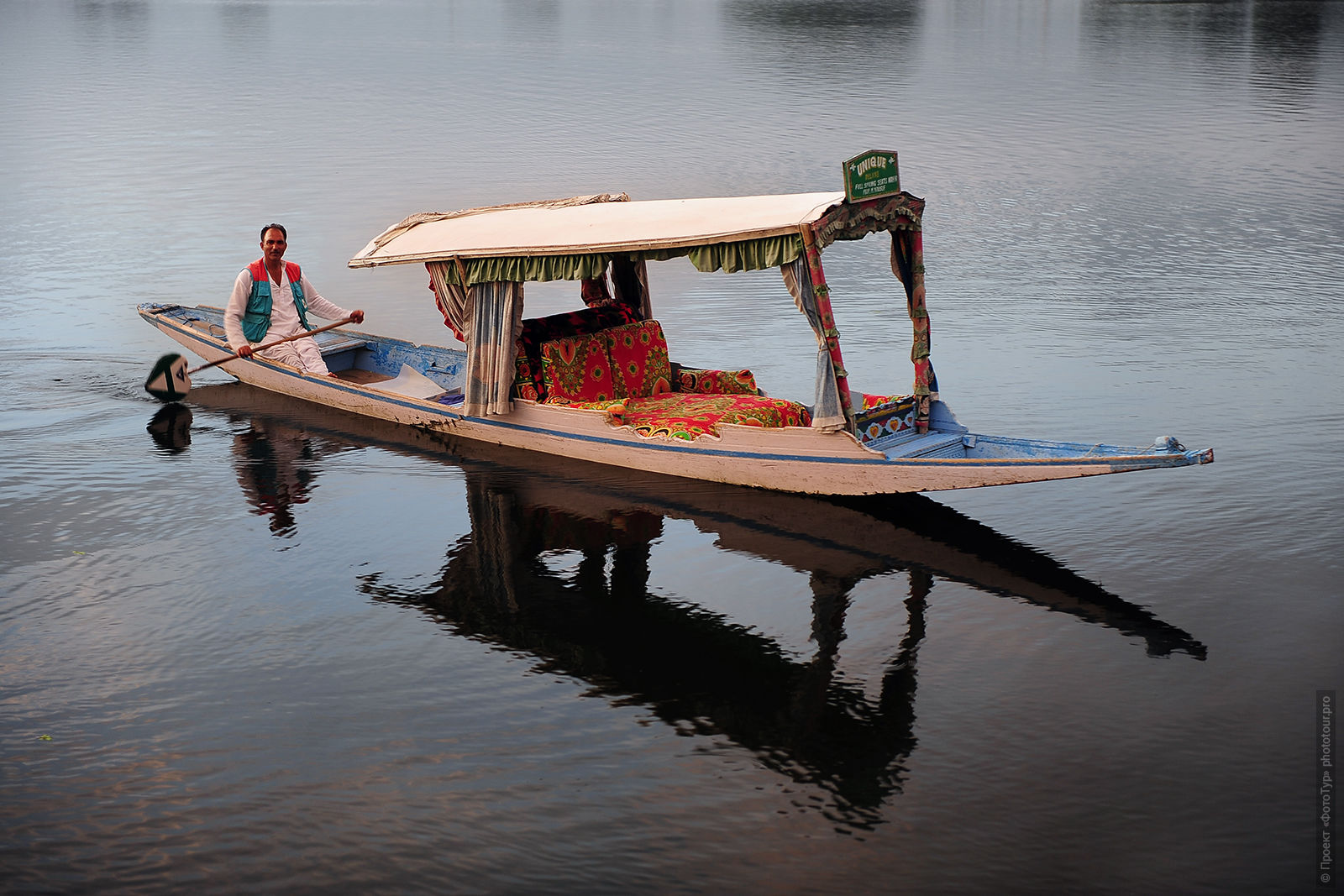
The boat trip on the Lake Dal: Kashmiris called the Lake Dal "jewel in the crown of Kashmir" and "Shrinagar treasure."
Shoreline length is about 15 kilometers of developed parks, hotels, canals.
The lake covers an area of about 18 square kilometers, but along with the marshes, flooded fields, floating gardens and canals total area is about 21.1 square kilometers, the maximum depth of the Lake Dal is 6 meters.
On the surface of the water are Komarov lotus, lily white, Nymphoides, Salvinia and other plants rise, taking up to 30 percent of the lake's surface.
Time of flowering of lotus on the Lake Dal - from June to September and is a strong likelihood that we will float and take pictures among the lotus gardens.
Also we visit the floating gardens that the Kashmiris themselves called "Rad": floating gardens grow in soil laid on reed rafts of two meters wide. If necessary, these rafts-gardens are fixed with anchors.
Deftly maneuvering in their boats, shrinagari farmers harvest tomatoes, cucumbers, melons, pumpkins and colorful flowers.
It is believed that the vegetables from floating gardens are very tasty and juicy.
The lake is a home for many fish, which makes it an important part of the Kashmiri economy.
Houseboat on the Lake Dal.
Day 12, September 9: Srinagar, Mughal Gardens: Chashma Shahi (Royal Spring), Shalimar Bahg (Abode of Love) and the Nishat Bagh (Garden of Delights).
In the morning, after breakfast at the houseboat, we go to watch and take pictures of a beauty - in the literal sense of the word: today will be dedicated to the gardens of Srinagar, which are considered to be the eighth wonder of the world.
It is worth to tell apart about Srinagar gardens - a bit of history:
In general, the formation of orchards - as the most natural action on fertile soils near the Dal Lake, dates back to the second century - any ruler of Srinagar adorned his city with gardens.
On the orders of the ruling here Mughal emperors in the Middle Ages there were organized 777 terraced gardens decorated with marble pavilions, canals and fountains in the surrounding hills.
In 1585, Kashmir was conquered by Akbar, the emperor of the Mughal dynasty, and became part of the Muslim empire.
The Emperor Akbar moved to Kashmir for summer time. It was the perfect whereabouts since Kashmir was relatively close to Delhi - a stronghold of his reign - and not far from the trade routes passing through the mountain passes.
Emperor Akbar declared Kashmir as his personal garden and was confident that local residents to only exist to take care of him.
He commanded to begin construction of magnificent palaces with gardens in Srinagar.
All the gardens are divided according to a definite plan, the mandatory rectangular stepped terraces.
Water flows into gardens of Srinagar through stone parapets, flows under the pavilions with series of stages, crosses the entire territory and finally flows into the Dal Lake.
And later - in 1633 according the project of Asahi Khan, the brother in law of Shah Jahan - the creator of the palace of the Taj Mahal, the garden Nishat Bagh ("Nishat" in Hindi means pleasure, "Bagh" – "Garden", Garden of Delights) was established in Srinagar, it occupies an area of 548 m long and 338 m wide.
According to the project of Shah Jahan the garden Shalimar Bagh was also created. This garden with its magnificent pavilions, flowing waterfalls and plenty of exotic flowers is the most beautiful in the world.
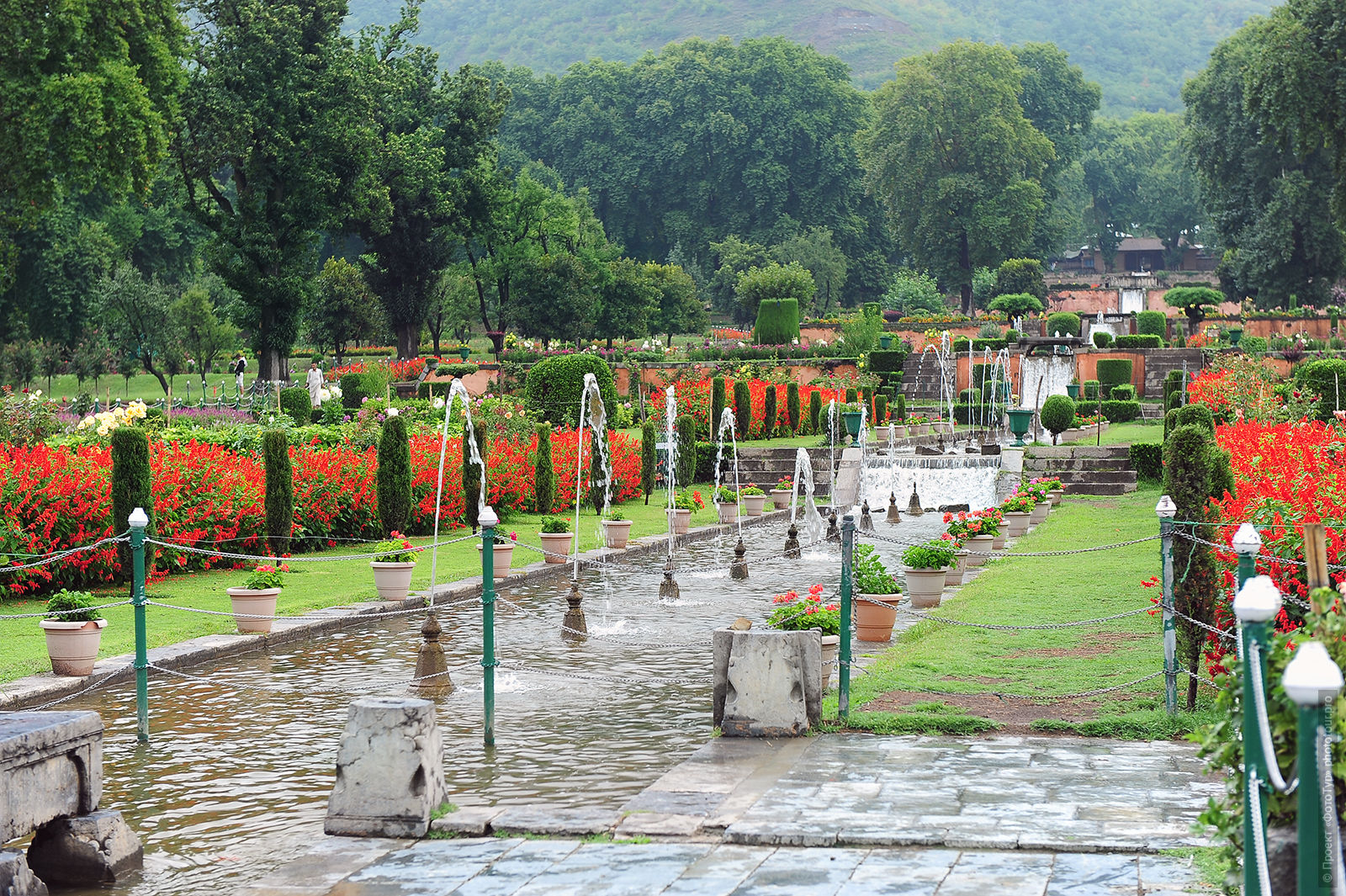
Today we visit the Mughal Gardens:
1. Chashma Shahi: means "King's Source", a spring with healing water and the garden around. Chashma Shahi is above the Nehru Memorial Park. It is the smallest Mughal Garden in Srinagar, ranked 108x38 meters and has three terraces, an aqueduct, waterfalls and a fountain.
Ali Mardan Khan made the garden in 1632, and so that a spring fed a fountain. Water flows from fountains through a special gutters through several waterfalls and drips on the polished black stone.
2. Shalimar Bagh: the Biggest Mughal Garden, built in the early seventeenth century by Emperor Jahangir for his wife Nur Jahan, who was just shocked by the beauty of Kashmir.
For a long time the couple have used this area as their summer residence and went here every spring from Delhi on a long journey on elephants. The next rulers landscaped the garden, expanding its territory and ennobling it with new plants and trees.
The famous pavilion have survived to our days, it was built of marble stone by Jahangir, with an inscription in Persian language - "If there is paradise on earth, it exists right here."
3. Nishat Bagh: This amazing and incredibly beautiful garden is called the Garden of Pleasure. The second largest Mughal Garden offers panoramic views of the snowy peaks of Pir Panjal Range and the Lake Dal.
Garden Nishat Bagh is a twenty minute drive from Srinagar.
If desired (for a fee) after an inspection of the Garden Nishat Bagh, you can go to Houseboat by water at the shikhar.
Houseboat on the Lake Dal.
Day 13, September 10: Srinagar: Floating Market. Shankaracharya Hill, the Temple of Shiva. Evening panoramic photographing of Srinagar.
At 4.30 in the morning we go to the floating market of Srinagar, the market itself is open daily from 5 am to 7 am, we sail on the market by shikharas and you can stay here as much as you want.
The market sell only the fresh products that have been grown by hand on the Lake Dal, basically - vegetables.
In addition to ethnographic photography this morning, there will be a landscape photography on the Lake Dal in the modal time in the morning.
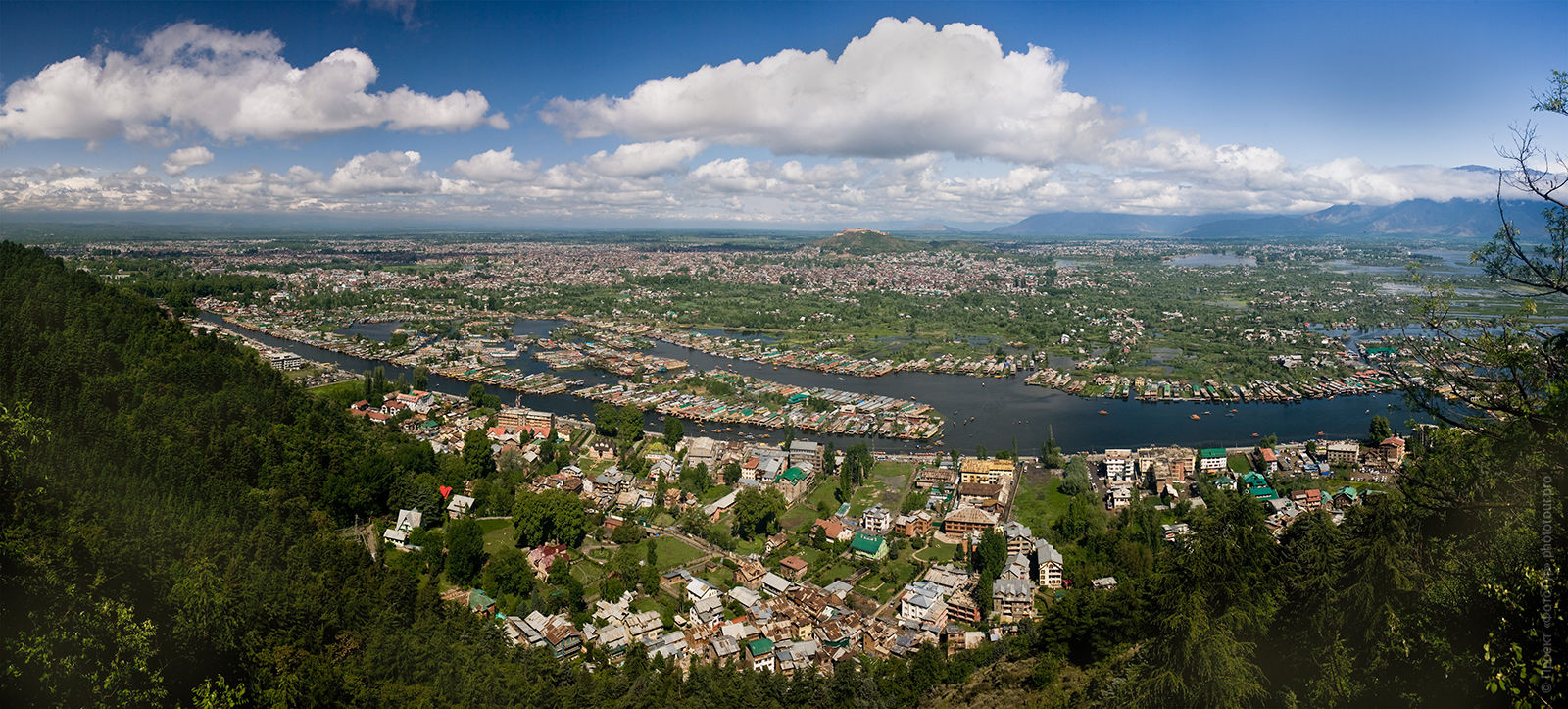
Return to the houseboat, dinner, packing.
Houseboat on Dal Lake.
Day 14, September 11: Flight Srinagar - Delhi. Return home.
In the morning - transfer to Srinagar airport and subsequent flight Srinagar - New Delhi, during the trip there will also be an opportunity to take photos of the Himalayan peak from the air.
Upon arrival in Delhi, a tour of Delhi is possible (upon prior arrangement), in the evening - transfer to the airport and return home.
